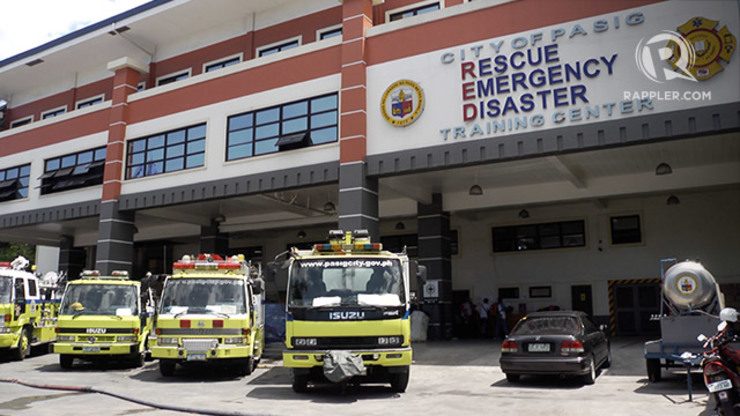SUMMARY
This is AI generated summarization, which may have errors. For context, always refer to the full article.

MANILA, Philippines – When Tropical Storm Ketsana or Ondoy hit Pasig City in 2009, flood waters submerged thousands of homes in the city.
In Barangay Santolan alone, home to 7% of Pasig’s population, around 30,000 residents were affected.
David Lozada reports that Ondoy served as a wake up call for the city.
Romeo Vasquez patrols the Pasig River and its communities.
The chief of Pasig City’s Fireboat Unit says his team is always ready to respond to disasters in the river.
ROMEO VASQUEZ, PASIG FIREBOAT CHIEF: Pinaka trabaho namin dito is drowning incidents. Kami ang nagreresponde. Mga kailangan respondehan sa tabing ilog, kami ang tumatakbo. Lalo na yung mga sunog sa tabing ilog from Pasig to Manila. Kami lang ang bumberong hindi nauubusan ng tubig. Kasi ang tubig namin ay galing sa Ilog Pasig. (We mostly respond to drowning incidents. But we also respond to different accidents in communities beside the river like fires. We’re the only firemen who never run out of water because our source is the river.)
Vasquez says he will never forget Ketsana or Ondoy in 2009.
ROMEO VASQUEZ, PASIG FIREBOAT CHIEF: Palibhasa kami lang ang may fire boat dito sa Pasig sa buong Metro Manila, kami ang nakapag-responde sa mga kailangan puntahan na bahay na mga sira. Kami rin ang dumadampot sa mga patay noong Ondoy. Actually noong araw ng Ondoy, araw araw kami dumadampot – 2 linggo yun na may dinadampot kaming patay. (We were the only ones with a fire boat here in Pasig and in the whole of Metro Manila so we were the ones who responded to those whose houses were wrecked. We were also the ones who gathered the dead bodies during Ondoy. Actually, during the aftermath of Ondoy, we would retrieve bodies everyday for 2 weeks.)
Ondoy was a wake up call for Pasig City.
The typhoon submerged many communities, both rich and poor, in flood waters.
The city started to improve its disaster mitigation, response plans and equipment in the flood’s aftermath.
In 2010, Pasig built its City Command Center to centralize response to incidents.
The local government installed over 220 CCTV cameras and weather gauging sensors.
The city also built a training center.
The city can now respond to calls for help within minutes.
RITCHIE VAN ANGELES, PASIG DRRM CHIEF: Usually, iyong tawag mag-stay lang yan ng almost one minute eh. Gano’n kabilis, lalo’t kung matter of life and death ‘yon, kailangan within one minute you get all the data and you transmit it immediately sa dispatcher para yung dispatcher makapagpadala ng tulong. (Rescue calls usually last for only one minute. It should be that fast especially if it’s a matter of life and death. The dispatcher gets all the needed information in one minute so he can mobilize help immediately.)
Pasig allots some 5% of its annual budget to reducing the risk and mitigating the impact of disasters.
In 2013, the city spent P244 million or 5.56 million dollars on disaster preparedness.
But Pasig DRRM Chief Ritchie Van Angeles says a big budget is not a prerequisite to being prepared.
RITCHIE VAN ANGELES, PASIG DRRM CHIEF: Ang importante magkaroon muna ng knowledge eh, kahit wala pang kasunod yung mga gamit. Maraming ways, kung gusto mo talaga. (What is important is that you have the disaster risk reduction and management knowledge first. The equipment can just follow after. If you really want the knowledge, there are many ways to conduct these kinds of seminars or training programs.)
There are lessons to be learned in every calamity. The key is good planning, training, networking and communication. Pasig City shows, with political will, a city can be resilient even if a river runs through it. David Lozada, Rappler, Pasig City.
Check out Rappler’s Project Agos microsite – a one-stop shop for educating the public on how to prepare better for disasters.
Project Agos aims to raise awareness on climate change adaptation and disaster risk reduction and management.
It can help people better prepare, respond, and aid in recovery.
Visit www.rappler.com/projectagos.
– Rappler.com
CORRECTION: In the video report we said that Pasig City built its city command center (C3) in 2010. Building the C3 actually started in 2007. We are sorry for the mistake.
Have a good story to tell about a group or individual involved in disaster preparedness and response education? Email us at move.ph@rappler.com.
The research for this case study was supported by the Friedrich Naumann Foundation for Freedom.
Check out the other case studies here:
- Tanay Mountaineers: A model of youth empowerment
- VIDEO REPORT: Tanay LGU and civil society work for disaster preparedness
- San Francisco: The island where all survived
- VIDEO REPORT: Disaster risk reduction in Camotes: The Purok system
- Pasig City: Learning from Ondoy, ready for the rain

Add a comment
How does this make you feel?
There are no comments yet. Add your comment to start the conversation.